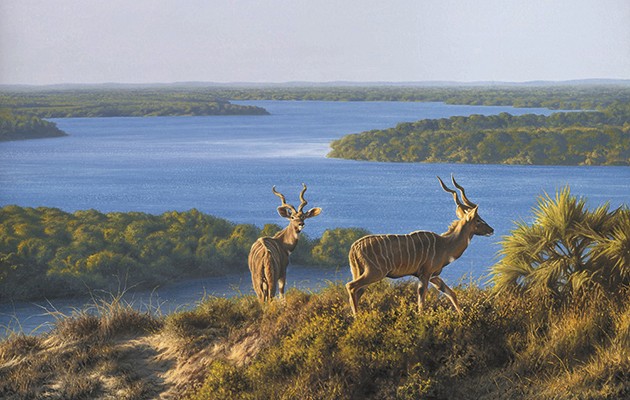African artist Paul Augustinus says he could spend a year in the bush and not need to see an animal. He talks to Janet Menzies about his passion for the wilderness and his concern for its future
Paul Augustinus conveys the real Africa in his work rather than the clichéd view from the back of a safari truck. Animals often do not take centre stage in his work, but when they do they are emblematic of essential Africa.
For more sporting artists, read about Bee Griffith and her lively canine portraits that perfectly capture man’s best friend, or Jonathan Sainsbury and his specialised artwork of birds.
PAUL AUGUSTINUS
Massive skies, often laden with lowering clouds, are distinctive features of the work of African wildlife artist Paul Augustinus. His huge vistas draw the viewer straight into the bush or the veldt, yet the animals themselves, so much part of the African mythology, are sometimes mere dots on the horizon. For Paul Augustinus, there is more to Africa than antelopes, as he explains: “I could spend a year in the bush and I don’t need to see one animal. I can hear the roar of the lions, or come across their tracks. The real Africa is not what you see from the back of a vehicle on a safari tour – that is becoming a clichéd view, something I have never experienced in the bush. Africa is not like that. Its real essence is the concept of wilderness, which is rooted in all of us. It is important that it is not a theme park or a fantasy. I want to convey the smell and the sound and the landscape and the feel of Africa.”
When he does give the animals centre stage, it is often because they are emblematic of essential Africa. Paul Augustinus describes his painting of antelopes such as the kudu as more of a personal quest than of painting. “To see animals properly, you must be prepared to walk, even if that means trekking into the interior. For example, to see one of the rare bongo antelopes means that you have really experienced the wilderness. It is all a calculated risk, but then, if there is no element of risk it isn’t worthwhile.”
If anyone has earned the right to paint the bongo, it is Paul Augustinus, as he has spent almost his entire life living rough in the African bush, with an iconic Toyota Land Cruiser as his only base. He remembers his first one: “It was an ancient three-speeder, but it never let me down. I have the latest version now, equally reliable, but I do miss that old one.”
Driving off to live and paint on his own in the bush as a young man didn’t strike Paul Augustinus as particularly brave. “It was just a way of enabling myself to keep doing the thing I passionately wanted to do. I can’t say there was any great plan. I saw the art as an opportunity to get some cash to support myself. Luckily,
I made enough money from selling paintings in the first few years to know that I could make a go of it.”
His own rather rackety childhood, though it would be considered dysfunctional by modern standards, actually gave Paul Augustinus the freedom to follow his passion for living in the wild. “Both my parents were risk takers who would be regarded today as not having been good parents, but it made it an easy choice for me to go out alone. People these days don’t do that. I think in the Western world now there is always a safety net, and the downside of that is that it discourages people from making the decisions that could lead to fuller, more adventurous lives.”
Now entering his sixties, a time when many artists would be settling down in a studio, Paul Augustinus still cannot let go of the wilderness: “This year I am going back to my original lifestyle for a while. I want to explore the equatorial rainforest and paint it from the inside. Few people really do venture into the rainforest, even though there is a kind of accepted view of it, and I need to think about that.”
Augustinus worries about the future of his beloved African wilderness. He remembers: “When I started out, Botswana was completely open country, with no tarred roads at all. Then 15 years ago they laid a tar road up to the edge of the Okavango. Now there are traffic cops on motorcycles! Change in Africa is taking place at such a huge pace. If I were starting again now, there would be opportunities, but I don’t think you could do what I did, in that very romantic way, just living out there alone. Of course, you can’t live in the past, but the wild environment of Africa is losing out. Land is the most valuable resource we have, and the great vacant wilderness areas are under huge pressure.”
For further details, visit the artists’s website www.paulaugustinus.com. His work is for sale at the Rountree Tryon Galleries, 7 Bury Street, London SW1; www.rountreetryon.com.





